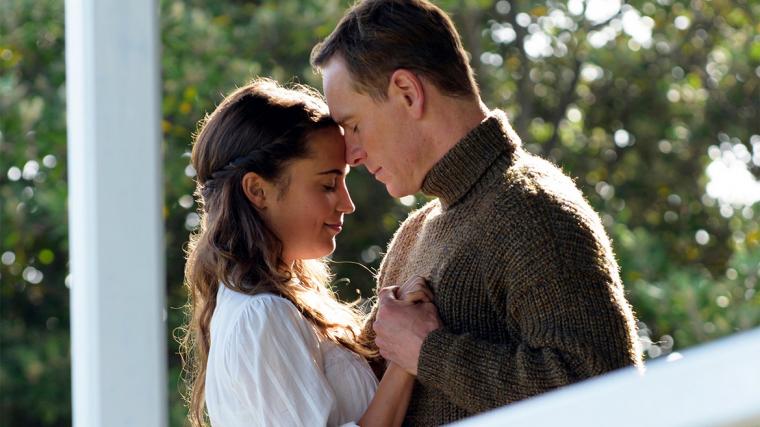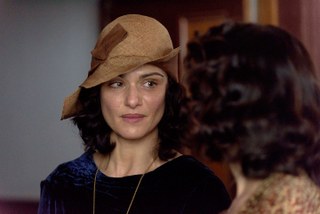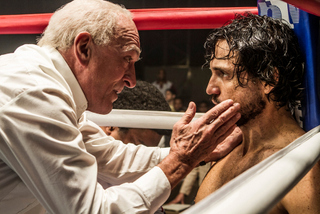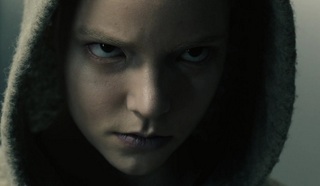
THE LIGHT BETWEEN OCEANS
Romantic dramas for adults have been so infrequent this millennium that it sometimes seems they appear only when studios feel the need for another generally laughable Nicholas Sparks adaptation, which makes it hard, in The Light Between Oceans, to know whether to swoon or chortle when – honest to God – a woman accepts a marriage proposal by saying, “Yes! Yes! A thousand times yes!” (I was sure that line had been put out to pasture after the demise of vaudeville.) Yet writer/director Derek Cianfrance is nothing if not sincere, occasionally to his detriment, and his take on novelist M.L. Stedman’s period romance is serious-minded, thematically resonant, and, at times, emotionally devastating in ways that the Sparks oeuvre almost never is. It’s the film’s second-half plot contrivances, and the unfortunate arm-twisting that accompanies them, that routinely bring Sparks to mind.
Had you somehow walked into The Light Between Oceans’ opening scene with no knowledge of what you were in for, you might expect something not unlike The Shining, given that Michael Fassbender’s traumatized WWI veteran Tom Sherbourne readily agrees to maintain a remote Australian lighthouse whose previous caretaker, we’re told, went mad with “cabin fever.” (Fear not; the guy didn’t have twin daughters.) But while Tom is clearly seeking solitude, it doesn’t last long, as he quickly falls for the beautiful, headstrong Isabel Graysmark (Alicia Vikander). After two visits, many months, and many more letters, the pair marries, and heads to the otherwise uninhabited lighthouse isle to raise a family. Their first pregnancy, however, ends in late-term miscarriage. Their second pregnancy does, too. And just as Tom is completing the gravesite for their newly unborn child and Isabel appears utterly inconsolable, a rowboat is seen floating in the distance. It washes ashore, and in it Tom and Isabel find a dead man and a perfectly healthy baby girl. Isabel, who wants to keep her, more or less argues that it’s God’s will. Tom, who wants to alert the mainland, more or less asserts that it’s God’s test.
Up to this moment, The Light Between Oceans is pretty phenomenal, principally because the romance works as well as it does. It can be a grim prospect to watch a character as guarded as Tom slowly thaw under the spell of a life force as strong as Isabel – even with gifted actors in the roles, there’s no guarantee that this setup won’t lead to some truly unwise under- and over-playing (which both Fassbender and Vikander can be fairly accused of in previous screen performances). Yet the film’s stars are magical here, and better yet they’re magical together. Fassbender so carefully delineates Tom’s reticence as guilt and shame for being alive when others have fallen, and Vikander so adroitly expresses Isabel’s desire to truly understand this handsome stranger, that even their simple getting-to-know-you conversations exude electricity and emotional hunger; there’s genuine need in the chastely romantic byplay.

But if Cianfrance keeps you smiling at Tom’s and Isabel’s courtship and early days of matrimony, he positively wrecks you with what comes immediately after. The scene of a housebound Isabel going into premature labor while her husband mans the lighthouse in the midst of a torrential, punishingly loud storm is a gut-wrencher out of the ’40s-melodrama playbook – and that’s not meant at all disparagingly. It’s somehow, however, no worse than the second miscarriage that occurs while Isabel gently plays the piano and Tom, unaware of her pains, reads a book a mere three feet away. (No one who’s seen Cianfrance’s Blue Valentine or The Place Between the Pines needs to be told that the filmmaker can demolish us with a glance as easily as with a punch.) Cianfrance, Fassbender, and Vikander are in such accord in these scenes that they don’t need excess melodrama or the sweep of composer Alexandre Desplat’s music to score their points; the tears you may release are ones earned honestly.
So it becomes all the more dispiriting – and this is my problem with the source material more than Cianfrance’s adaptation – when post-rowboat events years later kick the plot into high gear with the arrival of Rachel Weisz’s Hannah, a native of Isabel’s hometown who, it turns out, lost her husband and daughter in an oceanic tragedy. (After The Lobster, this is now the second 2016 release in which Weisz has shown up an hour into a movie to turn our male lead’s life upside-down.) I certainly recognize that without this development, the Light Between Oceans book/movie wouldn’t exist. But I also couldn’t help noticing that my personal feelings for the film went completely neutral with the advent of this narrative turn. Why was Tom, as the lighthouse-keeper, so blinded by this revelation? Wouldn’t Australian officials have asked him, in his daily duties, to be on the lookout for an errant rowboat? Barring that, would Tom’s reaction to Hannah’s loss really have led to quite so many narrative twists of the knife, and quite so many convenient melodramatic conceits, with Anthony Hayes acting as a sort of Inspector Javert to Fassbender’s and Vikander’s combined Jean Valjean?
And did it all have to be so pushy? During the movie’s first half, Cianfrance’s camera maintains a mostly discreet distance from our characters. But that discretion goes out the window in the final hour, with Weisz and Vikander, especially, forced into uncomfortably invasive, soft-focus closeups of their characters’ suffering, and the confused turmoil of the child Lucy – played as a four-year-old by the lovely and spontaneous Florence Clery – used for maximum manipulation. The Light Between Oceans is wonderful until suddenly, sadly, it isn’t. And the film’s multiple endings – among them a series of gauzy flashbacks and the 1920s equivalent of a climactic Race to the Airport – confirm that, in the end, Cianfrance may not have been entirely sure what kinds of feelings he wanted to leave us with. The one I surely left with was the feeling that I’d just witnessed something incredibly unusual: a truly great near-miss.

HANDS OF STONE
It takes less than a minute to feel somewhat offended by Hands of Stone, because that’s how quickly you realize that this cinematic life story of Panamanian boxing icon Roberto Durán is going to be told from the perspective of an old white guy. I wasn’t surprised, even if I was disappointed, that writer/director Jonathan Jakubowicz detailed Durán’s legend within the well-worn 12-step program of triumph-of-the-underdog sports flicks: humble roots, determined youth, big break, bigger break, mass fame, career high, unbridled ego, fall from grace, lowest ebb, humbled acceptance, vigorous return, ultimate redemption. (Lather, rinse, and repeat for all such genre entries now and forevermore.) But given how electrifying Edgar Ramírez’s channeling of Durán turns out to be, was it really necessary to have the boxer’s entire history narrated by Robert De Niro’s salt-of-the-earth trainer Ray Arcel – even Durán’s rationale for notoriously ceding (“No más”) his 1980 championship bout with Sugar Ray Leonard? Hands of Stone is like being promised a two-hour audience with Neil Armstrong and instead being shown a two-hour filmstrip about the moon.
This isn’t meant to demean De Niro, whose voice-over work is fine, and whose on-screen portrayal of Arcel – the requisite tough-but-tender supporter who serves as both mentor and father figure – is one of the actor’s more relaxed, effective offerings of recent years. (I was, however, admittedly distracted a bit by De Niro's rather uncanny resemblance to Ed Asner.) It’s meant, rather, to underscore Jakubowicz’s unfortunate lack of imagination in his tale’s telling, with its presentation becoming increasingly clumsy in the mid-film subplots involving Durán’s absent father and Arcel’s heroin-addicted daughter that the movie would’ve done well to excise. Even Jakubowicz’s boxing sequences are depressingly traditional, especially in the wake of Ryan Coogler’s thrillingly staged matches in Creed, and you get zero points for correctly guessing that it’ll all end with title cards explaining what eventually happened to whom – even the whom whom the movie barely introduces us to. Thankfully, however, there’s at least De Niro, and juicy brief turns by John Turturro and Ellen Barkin, and Reg E. Cathey pops in as promoter Don King, complete with King’s finger-in-a-light-socket hairdo and Cathey’s magnificent baritone that makes Vin Diesel sound like Kristin Chenoweth. And although War Dogs’ Ana de Armas, sadly, is stuck in her second fretful-wife role in three weeks, and Usher Raymond is one-dimensionally glib as Sugar Ray, Ramírez is really quite something, delivering a Durán who’s alternately ferocious, playful, intimidating, pitiful, and inspiring. In most of his Hollywood outings, including his 2015 two-fer of Joy and that needless Point Break remake, Ramírez oftentimes seems so recessive and uncomfortable that he appears to be on the verge of disappearing. But Durán is easily the most expressive outlet for his talents since Ramírez’s sublime, titular turn in the 2010 miniseries Carlos – another role that allowed the native Venezuelan to perform much of it in Spanish. It used to be said of aquatic marvel Esther Williams that “Wet, she’s a star.” At present, en español, Ramírez is a star. Were Hands of Stone a better movie, he may have also, finally, become one en inglés.

MORGAN
If the first voice you hear in a movie is Jennifer Jason Leigh’s, and it’s soon followed by the voice of Brian Cox, you can pretty much count on that movie boasting a fair degree of eccentricity. But despite the participation of these and other acting talents, director Luke Scott’s horror thriller Morgan isn’t nearly as eccentric as it needed to be. The Morgan of the title is a bio-engineered humanoid created for reasons unknown, and kept in a secluded woodland compound in upstate New York. Five years old but adult in intellect and appearance (and played by a seemingly lacquered Anna Taylor-Joy), Morgan is currently under observation for repeatedly stabbing a caregiver in the eye with a fork – which you’d think would be a sign that, you know, maybe we shouldn’t be in the business of bio-engineering humans. Still, the staffers love her and will do anything to protect her, which proves convenient when Lee Weathers (Kate Mara) arrives on the scene to gauge Morgan’s development. Lee introduces herself as “a risk specialist from corporate.” Leigh, the stabbed caregiver, knows better: “You’re an assassin.”
In addition to Mara, Leigh, Cox, and Taylor-Joy (the latter of whom played the accused teen sorceress in February’s The Witch), the unexpectedly supple ensemble here includes Boyd Holbrook, Toby Jones, Game of Thrones’ Rose Leslie, Michelle Yeoh, and Paul Giamatti. That’s practically a B-lister all-star game, and in rough outline Morgan is sort of like Ex Machina meets Hanna meets Room – a hybrid that almost can’t help but yield some trashy fun. That’s why it’s all the more disappointing that this feature debut by the son of producer Ridley Scott proves so conventional – or more accurately, so obvious. Mere minutes into Mara’s early introduction, I whispered what I presumed would be the movie’s “big twist” into my handheld recorder, and get no pleasure in telling you that, an hour and a half later, I was proved right; Seth W. Owens’ screenplay may be grossly indebted to other works, but it also boasts perhaps the least shocking shock ending of the decade. Add to this the film’s merely serviceable staging, thuddingly expository dialogue, continuity glitches (night turns to day awfully quickly in these woods), and unpleasant climactic slugfests in which every punch sounds like a baseball bat smacking a piñata, and Morgan emerges as a forgettable bummer, if one occasionally enlivened by its cast. It’s not every movie, after all, that provides the glorious sight of Paul Giamatti screaming at a five-year-old like she was a glass of Merlot.










